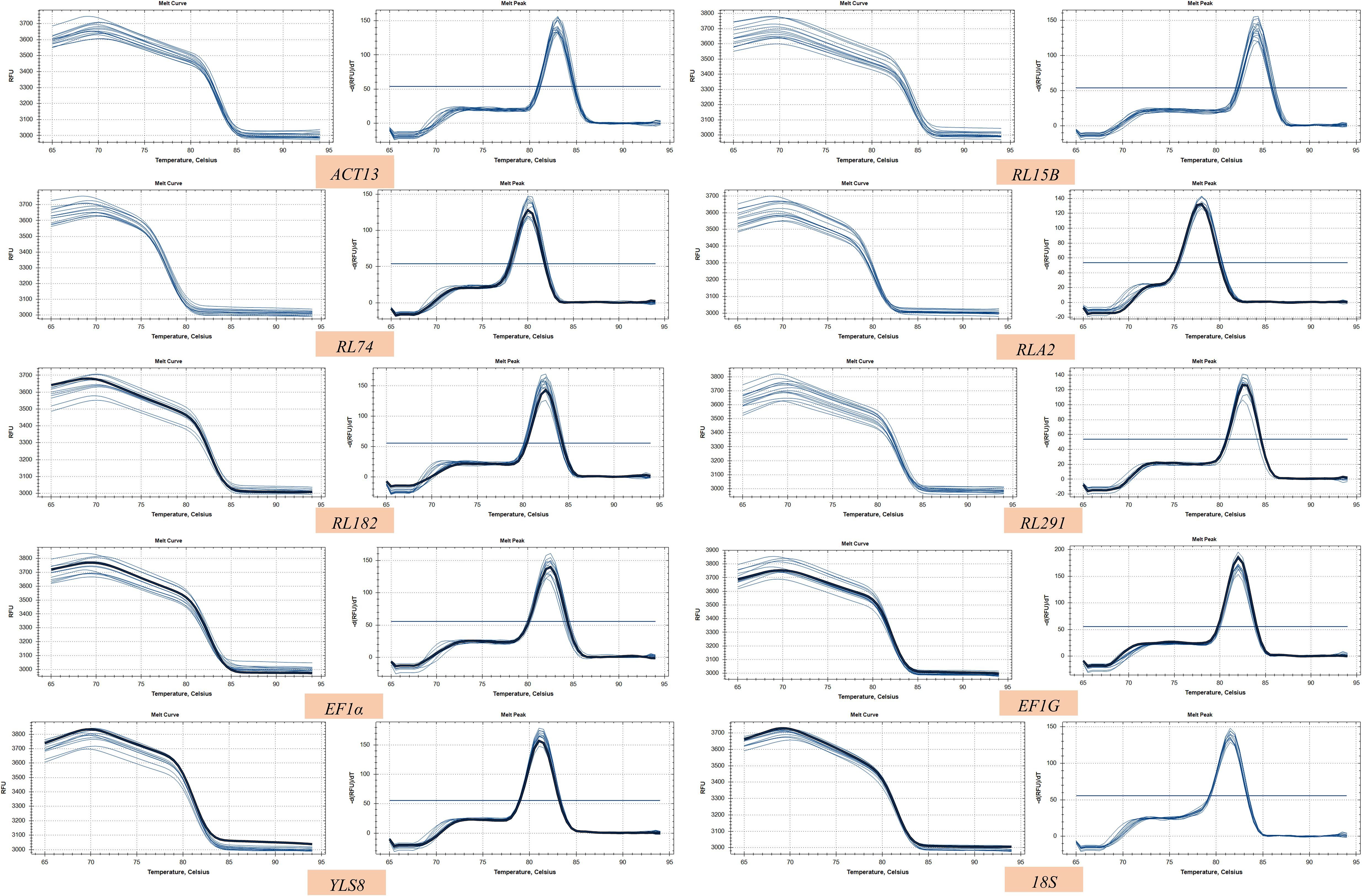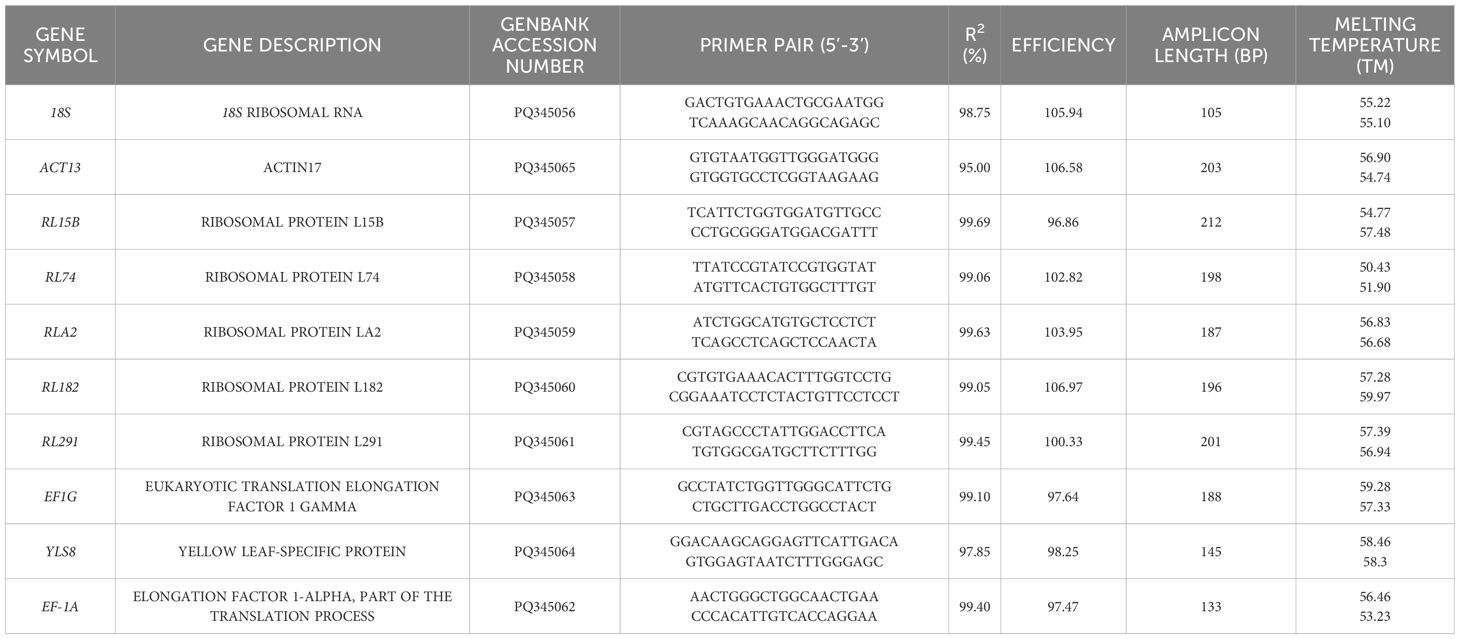- 1Key Laboratory of Resource Biology and Biotechnology in Western China, Ministry of Education/College of Life Science, Northwest University, Xi’an, Shaanxi, China
- 2Institute of Chinese Materia Medica, Shaanxi Academy of Traditional Chinese Medicine, Xi’an, Shaanxi, China
- 3School of Pharmacy, Guizhou University of Traditional Chinese Medicine, Guiyang, China
Introduction: Quinolizidine alkaloids, such as matrine and sophocarpine, enriched in Sophora davidii seeds, demonstrate notable anticancer properties. However, the biosynthetic pathway of these alkaloids remains incompletely elucidated, and the expression patterns of key enzyme genes involved in this pathway require further investigation. Quantitative real-time PCR (qRT-PCR) serves as a highly sensitive method for gene expression analysis, yet selecting appropriate reference genes is crucial to ensure the accuracy and reliability of results.
Methods: Ten candidate reference genes (18S, ACT13, RL15B, RL74, RLA2, RL182, RL291, EF1-α, EF1G, and YLS8) were evaluated for their expression stability in Sophora davidii seeds collected at five distinct developmental stages post-flowering, characterized by significant morphological changes. Five computational tools—GeNorm, NormFinder, BestKeeper, ΔCt, and RefFinder—were employed to comprehensively analyze the stability of these genes.
Results: Among the candidate genes, EF1G and RL291 exhibited the highest expression stability, whereas RL182 proved unsuitable as a reference gene. Validation experiments confirmed that normalization using stable reference genes (e.g., EF1G and RL291) yielded accurate quantification of target gene expression.
Discussion: This study identifies EF1G and RL291 as optimal reference genes for qRT-PCR analysis during Sophora davidii seed development, addressing a critical methodological gap in alkaloid biosynthesis research. These findings underscore the necessity of rigorous reference gene validation to ensure reliable gene expression data. The results advance our understanding of quinolizidine alkaloid biosynthesis and highlight the broader importance of reference gene selection in plant molecular studies.
Introduction
Sophora davidii (S. davidii), also known as Sophora viciifolia (Xu et al., 2023), is commonly found in hillside, wayside, or bush habitats at elevations spanning from 2000 to 3500 meters (Tai et al., 2011). It has a wide distribution across China, with prominent occurrences in Guizhou, Yunnan, and the northwestern regions. This plant can thrive in diverse environments, highlighting its significant ecological adaptability and diversity (Wang and Yilihamu, 2021). As a pioneer shrub species, it plays a crucial role in protecting rangelands from wind erosion and is of great significance in maintaining the stability of desert ecosystems.
In traditional Chinese medicine, the roots, leaves, flowers, and seeds of S. davidii have long been utilized to treat internal heat, sore throats, and swelling (Li et al., 2009). This plant is rich in alkaloids such as matrine (MT), oxymatrine (OMT), and sophoridine (SRI), which are well-known for their medicinal properties (Zhang et al., 2021), including antitumor (Li et al., 2020; Rashid et al., 2019; Bunsupa et al., 2012), antiviral (Zhang Y. B. et al., 2018; Zou et al., 2020; Zhang T. et al., 2024), anti-inflammatory, and antibacterial effects (Wink, 2019; Chen et al., 2005; Wang et al., 2021, 2019; Li et al., 2023; Zhang B. C. et al., 2018; Lin et al., 2019). Furthermore, with its profuse flowers and ample nectar, S. davidii serves as an important honey-producing plant in the spring, yielding high-quality honey (Wang et al., 2023).
Currently, molecular biology research on S. davidii is still in its early stages, and there is relatively limited research on the identification of reference genes for gene expression analysis. Understanding gene expression changes is a critical initial step in studying gene function. To compare gene expressions among different samples, it is essential to first normalize the data using a common factor (Yim et al., 2015). With the continuous progress of related research, the identification of stable reference genes for the study of gene expressions in S. davidii has become increasingly important. To further explore the synthesis mechanism of active compounds in S. davidii, an analysis of the expressions of relevant genes is required.
Quantitative real-time polymerase chain reaction (qRT-PCR) is widely employed in molecular biology and medical research to measure gene expression levels due to its high sensitivity, specificity, accuracy, and speed (Zhao X. D. et al., 2022; Freitas et al., 2021; Zhao J. M. et al., 2022; Fazzina et al., 2024). The reliability of qRT-PCR results depends on the selection of stable reference genes to standardize target gene data (Huggett et al., 2005). However, the expressions of reference genes may vary depending on the tissue or material being studied, which can affect the interpretation of the data. Therefore, selecting reference genes with stable expressions is crucial for ensuring accurate gene expression analysis (Lucho et al., 2018). Studies have shown that no single reference gene can maintain stable in all tissues and under all experimental conditions. The stability of reference gene expression typically depends on specific tissues or experimental environments (Remans et al., 2014; Chen et al., 2020). Previous studies have shown that there are significant differences in the expression patterns of housekeeping genes based on genetic profiles, cell types, and experimental parameters (Panina et al., 2018). Under different conditions, the use of inappropriate reference genes can lead to inaccurate expression profiles of target genes. Currently, suitable reference genes have been identified for plants such as Codonopsis pilosula (Liang et al., 2020), Artemisia sphaerocephala (Hu et al., 2018), Kengyilia melanthera (Zhao J. M. et al., 2022), Isatis indigotica Fort (Li T. et al., 2017), and Dalbergia odorifera (Meng et al., 2019). Changes in gene expression levels are direct biomarkers for evaluating an organism’s response to environmental changes (Kubista et al., 2006). In theory, the expression levels of reference genes should be consistent across all samples. However, practical studies have demonstrated that no reference gene can be stably expressed in all tissues and under all conditions. Stable expressions of specific reference genes is often only observed in specific tissues or under specific conditions (Wang and Bhullar, 2021; Li et al., 2019; Zhou et al., 2019; Zheng et al., 2018). qRT-PCR not only allows for the precise quantification of target gene expressions under controlled conditions but also provides valuable insights into the gene regulatory mechanisms underlying the biosynthesis of active compounds.
RNA sequencing (RNA-seq) has emerged as a vital tool for comprehensive gene expression analysis. Leveraging the Illumina sequencing platform, RNA-seq can detect all mRNA transcripts in specific tissues or cells at specific time points, which is of great significance for understanding gene function and structure (Wang et al., 2009). This approach plays a crucial role in uncovering the developmental processes and disease mechanisms of organisms (Wang et al., 2009; Majewski and Pastinen, 2011). RNA-seq is widely employed to identify genes with differential expressions under various experimental conditions. Genes that exhibit stable expressions across different tissues or conditions are potential candidates for reference genes (Stanton et al., 2017; Bowen et al., 2014). However, to date, no research has identified genes with stable expressions in S. davidii, and there is limited information regarding the identification and validation of qRT-PCR normalized reference genes in S. davidii.
In earlier research, we discovered that the alkaloid content in the seeds of S. davidii was higher than that in other tissues (Xu et al., 2024). In this study, we collected seeds from different developmental stages of S. davidii. 10 commonly used housekeeping genes were selected, namely 18S ribosomal RNA (18S), actin-13 (ACT13), ribosomal protein L15-2 (RL15B), ribosomal protein L7-4 (RL74), acidic ribosomal protein P2 (RLA2), ribosomal protein L18-2 (RL182), ribosomal protein L29-1 (RL291), elongation factor 1-α (EF1-α), eukaryotic translation elongation factor 1 gamma (EF1G), and thioredoxin-like protein YLS8 (YLS8). At different stages of seed development, statistical methods such as ΔCT, GeNorm, NormFinder, BestKeeper, and RefFinder were utilized to evaluate these genes.
Additionally, we validated the selected reference genes by analyzing Lysine decarboxylase (LDC), which is involved in alkaloid biosynthesis (Mancinotti et al., 2022), along with nine genes associated with seed size and lipid synthesis. These nine genes include fatty acid desaturase (FAD) (Al Amin et al., 2019), transcription factor MYB73 (MYB73) (Liu et al., 2014), B3 domain transcription factor LEC2 (LEC) (Manan et al., 2017), transcription factor encoding (NYFA) (Lu et al., 2016), the enzyme encoding the rate-limiting step of gibberellin biosynthesis (GA20OX) (Lu et al., 2016), phosphatase 2C (PP2C) (Lu et al., 2017), cytochrome P450 78A (CYP) (Wang et al., 2015), G-patch domain-containing protein (GPAT) (Hirawake-Mogi et al., 2021) and plasma membrane intrinsic protein (PIP) (Lu et al., 2018). The findings of this study are expected to provide valuable references for elucidating the molecular mechanisms governing the development of S. davidii.
Materials and methods
Plant materials
The seeds of S. davidii were collected near Longshan Park in Yijun County, Tongchuan City, Shaanxi Province (35°23’2.9292”N, 109°6’40.7448”E). The relevant samples were archived at the Shanxi Academy of Traditional Chinese Medicine. S. davidii samples were harvested from June to September 2023 and categorized into five groups according to the maturity status of the fruits. The S1 stage of S. davidii is shortly after flowering. At this time, the pods are starting to develop, and the seeds are still small and underdeveloped. We collected seeds at the S1 stage during this particular growth phase. The S2-stage samples were collected 22 days after the collection of S1-stage seeds. By this time, the pods had slightly enlarged. The S3-stage seeds were harvested 34 days after the S1 stage, when the seeds began to swell. The S4-stage samples were collected 49 days after the S1 stage. During this period, the seeds in the pods showed a significant increase in size and became plump. The S5-stage samples were collected 64 days after the S1 stage. At this time, the pods were nearly dry, and the seeds were close to full maturity (Supplementary Figure S1). After harvesting, we removed the pod skins to extract the seeds. The seeds at each developmental stage were divided into three equal portions and stored under deep-freezing conditions at -80°C until RNA extraction was conducted.
Selection of candidate reference genes
Candidate reference genes are commonly employed as housekeeping genes in both model and non-model plant species (Hu et al., 2022; Ferreira et al., 2023; Schmidt and Delaney, 2010; Radonić et al., 2004; Li J. T. et al., 2017). In this study, we initially identified genes that have been validated to exhibit stable expressions in plants through a comprehensive literature review. Subsequently, based on RNA-seq data, we selected co-expressed genes with FPKM values showing a difference of less than 2 across different samples. Finally, from common housekeeping genes, we chose 10 candidate reference genes, namely 18S, ACT13, RL15B, RL74, RLA2, RL182, RL291, EF-1α, EF1G, and YLS8. We used PRIMER PREMIER 5.0 software (San Francisco, California, USA) or primer design. The primers were synthesized by Tsingke (Beijing,China). A standard curve was generated by diluting the cDNA four-fold. Based on this curve, we determined the amplification efficiency (E) and correlation coefficient (R2) of the primers. The amplification efficiency of each primer pair was calculated according to the slope of the linear regression model, using the formula: E = [10−1/slope− 1] × 100% (Chen et al., 2023; Vandesompele et al., 2002; Andersen et al., 2004).
Total RNA isolation
For each biological sample, it was rapidly ground into a fine powder in liquid nitrogen. Approximately 100 mg of the powdered sample was then weighed, and RNA was extracted using the Trizol reagent. After extraction, the RNA was dissolved in ribonuclease-free water, and the RNA concentration was measured using a ThermoScientific spectrophotometer (SN-1530-801015, Multiskan Sky with Touch Screen). The integrity of the RNA was evaluated by performing 1% agarose gel electrophoresis. The results revealed distinct and intact bands corresponding to the 18S and 28S ribosomal RNA.
Approximately 1 µg of RNA was taken from each sample for cDNA synthesis. First-strand cDNA synthesis was performed using the TransScript All-in-One First-Strand cDNA Synthesis Supermix for qPCR (One-step gDNA removal) (TransGen Biotech, Beijing, China). The synthesized cDNA was diluted four-fold and stored at -20°C for subsequent qRT-PCR.
The gene expression levels in the cDNA samples were evaluated via qRT-PCR. The established qRT-PCR protocol was strictly followed to ensure high-quality RNA for subsequent analysis. The PCR procedure was as follows: 94˚C for 30 s, 42 cycles of 94˚C for 10 s, 60˚C for 30 s, and 72 ˚C for 10 s, with a single melt cycle from 65˚C to 94˚C in 5 s intervals. The Ct values were recorded and further analyses were conducted.
Reference gene expression stability analysis
The raw fluorescence values obtained from the qRT-PCR experiments were imported into Microsoft Excel 2019. Then, the stability of each candidate gene was analyzed using five different methods, namely GeNorm, NormFinder, BestKeeper, and ΔCt (Vandesompele et al., 2002; Andersen et al., 2004; Pfaffl et al., 2004; Silver et al., 2006). Subsequently, RefFinder (Xie et al., 2012, 2023) was combined with ΔCt, GeNorm, NormFinder, and BestKeeper to comprehensively rank the candidate reference genes and assess their stability.
Validation of reference genes
The expression levels of SdLDC (Mancinotti et al., 2022) and a series of related genes involved in regulating seed size and oil synthesis (such as FAD2 (Al Amin et al., 2019), MYB73 (Liu et al., 2014), LEC (Manan et al., 2017), NYFA (Lu et al., 2016), GA20OX (Lu et al., 2016), PP2C (Lu et al., 2017), CYP (Wang et al., 2015), GPAT (Hirawake-Mogi et al., 2021) and PIP (Lu et al., 2018)) were normalized using single or multiple reference genes to assess the reliability of the selected reference genes during different developmental stages of S. davidii seeds. The stability of the reference genes was validated using the 2-ΔΔct method (Livak and Schmittgen, 2001; Ginzinger, 2002). The qRT-PCR amplification conditions were the same as the conditions described above. The primer sequences for the target genes are detailed in Supplementary Table S1.
Statistical analysis for qRT-PCR
Each experiment was performed with three technical replicates. A statistical analysis of variance was carried out on the data obtained from qRT-PCR. With the use of GraphPad Prism 8.3 software (San Diego, California, USA), one-way analysis of variance was employed to test the mean values of each separation at a significance level of 0.05.
The RNA-Seq data used in this study has been uploaded to the NCBI’s GenBank database under the archive number Bankit2870280.
Results
Transcriptome data quality analysis
For each developmental stage, cDNA libraries were established with three biological replicates, culminating in a total of 15 libraries. Upon sequencing, each library generated an average of 41,303,713 high-quality clean reads. The Q20 scores exceeded 97%, and the Q30 scores were above 92%. Across all samples, the GC content remained remarkably consistent, ranging from 43% to 46% (Supplementary Table S2). Based on these results, it is evident that the transcriptomic data obtained fully meet the requirements for the screening of target genes.
Verification of primer specificity and PCR efficiency analysis
RNA extraction yielded high-quality samples that were well-suited for qPCR analysis (Supplementary Figure S2). The standard curve was generated by performing four-fold serial dilutions of the cDNA pool (Supplementary Figure S3). The melting curves of all the candidate genes exhibited distinct single peaks (Figure 1). The amplification efficiencies of the 10 candidate reference genes ranged from 96.7% to 106.6%, while their correlation coefficients fluctuated between 0.95 and 1 (Table 1).
Expression stability of candidate reference genes
10 candidate reference genes were selected for this study. The annealing temperature for primer design ranged from 50.43°C to 59.28°C, and the length of the amplified products varied from 105 bp (corresponding to the 18S gene) to 212 bp (corresponding to the RL15B gene) (Table 1). The expressions of these 10 candidate reference genes were assessed by qRT-PCR experiments, with each sample having three technical replicates.
The expression levels of the candidate reference genes were determined based on the Cq values across all samples (Figure 2). The average Cq values were distributed between those of ACT13 and 18S. Generally, a lower Cq value indicates a higher expression level, whereas a higher Cq value represents a lower expression level (Li et al., 2016). Among all the samples, 18S demonstrated the highest expression level (9.66 ± 1.33), whereas RLA2 exhibited the lowest expression level (29.35 ± 1.76). Among the 10 analyzed genes, RL291 demonstrated a limited range of variation, with expression levels spanning from 23.42 to 26.37. In contrast, RL182 exhibited the highest degree of variability, with expression levels ranging from 23.38 to 31.76 (Supplementary Table S3). The expression profiles of the reference genes were visualized using Ct values presented in a box plot, which enabled an initial evaluation of their stability. The preliminary analysis results suggested that the expression levels of several genes, including EF-1α, RL291 were relatively stable and showed high expression levels. However, the coefficients of variation of the 18S and RL182 genes reached 13.35% and 10.17%, respectively, suggesting that the expression stability of these two genes was relatively poor among the five samples (Supplementary Table S3, Figure 2).
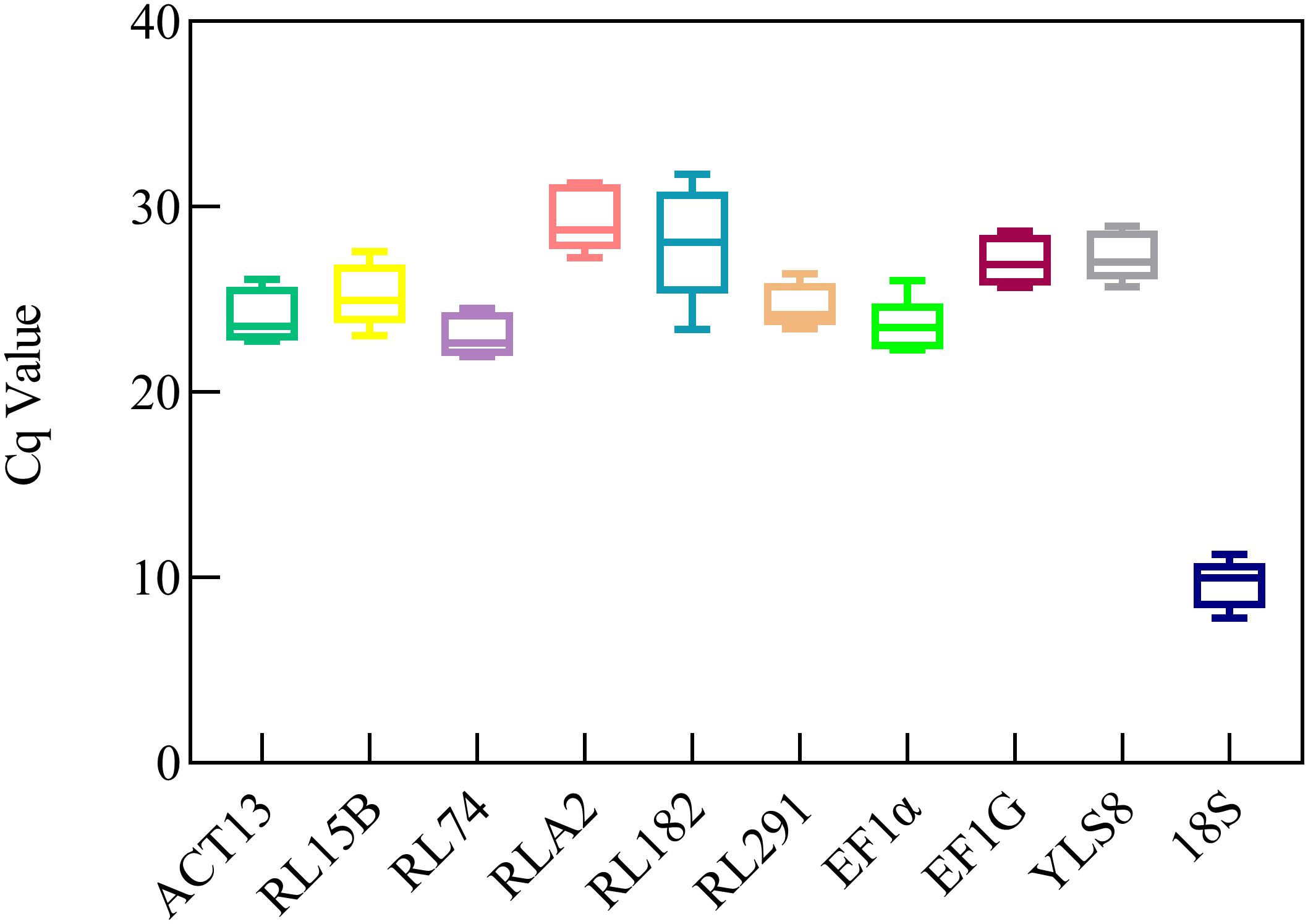
Figure 2. Quantification cycle (Cq) values of tent candidate reference genes in S. davidii. A line across the box depicts the median. The box indicates the 25% and 75% percentiles. Whiskers represent the maximum and minimum values. The Figures were generated by using graphpad prism 8.3 software http://www.graphpad.com.
GeNorm analysis
The average stability value (M) of the candidate internal reference genes was determined using GeNorm. Generally, a lower M value indicates greater stability of gene expression. A threshold has been set at an M value of less than 1.5 (Vandesompele et al., 2002). The results revealed that the M values of all 10 candidate reference genes were below this threshold, suggesting that their expression was relatively stable and they were preliminarily deemed suitable as reference genes. Based on the analysis by GeNorm, the combination of ACT13 and EF1G exhibited the lowest M value (0.2580), indicating the most stable expression. In contrast, RL182 presented the highest M value (1.0391), reflecting the least stable expression across different developmental stages of S. davidii seeds (Figure 3A). To enhance the accuracy and reliability of the evaluation, GeNorm also determines the optimal number of reference genes by analyzing the pairwise differences in the normalization factors of candidate endogenous genes (Vn/Vn+1). When the Vn/Vn+1 value is less than 0.15, it suggests that the selected combination of reference genes is sufficient to achieve stable normalization, thereby ensuring the accuracy and reliability of the experimental outcomes (Vandesompele et al., 2002; Li J. T. et al., 2017). Notably, during the various stages of seed development, the V2/3 value was recorded at 0.124, which was lower than the predefined threshold of 0.15. This finding indicated that the first two genes (EF1G and ACT13) were sufficient for validation purposes (Figure 3B). However, it should be emphasized that the V value mainly serves as a guideline for selecting the optimal number of reference genes, and the threshold of 0.15 is not an absolute critical value. Typically, to achieve more robust normalization, it is recommended to use three reference genes. This approach often yields more reliable results compared to using a single reference gene (Vijayakumar and Sakuntala, 2024; Hu et al., 2023).
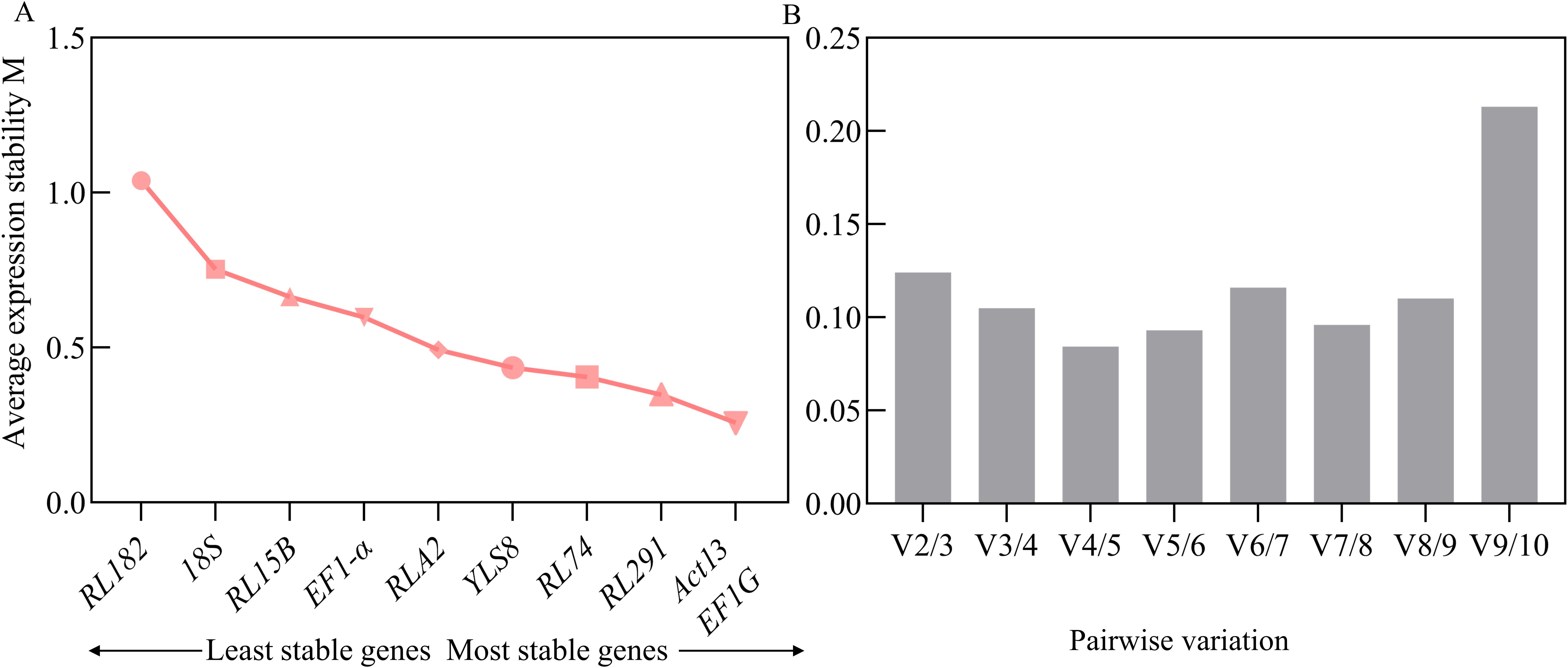
Figure 3. GeNorm software anlysis of the candidate reference genes. (A), Average expression stability values (M) of the candidate reference genes were calculated in S. davidii samples. (B), The expression stability and pairwise variation values of ten reference genes obtained, the Pairwise variation (Vn/Vn+1) between the normalization factors was calculated using the geNorm software program to determine the optimal number of candidate reference genes.
NormFinder analysis
The operational process of NormFinder is comparable to that of GeNorm, as it assesses gene stability by evaluating and quantifying gene expression stability values. Generally, a lower stability value corresponds to higher gene stability (Andersen et al., 2004). When compared to the gene stability ranking generated by GeNorm, the ranking produced by NormFinder showed some variations. Notably, there was a high degree of consistency between the two in terms of the initially identified stable reference genes, with only minor differences in the rankings (Table 2). Furthermore, both tools identified EF1G as the most stable candidate reference gene, indicating consistency between the two tools.
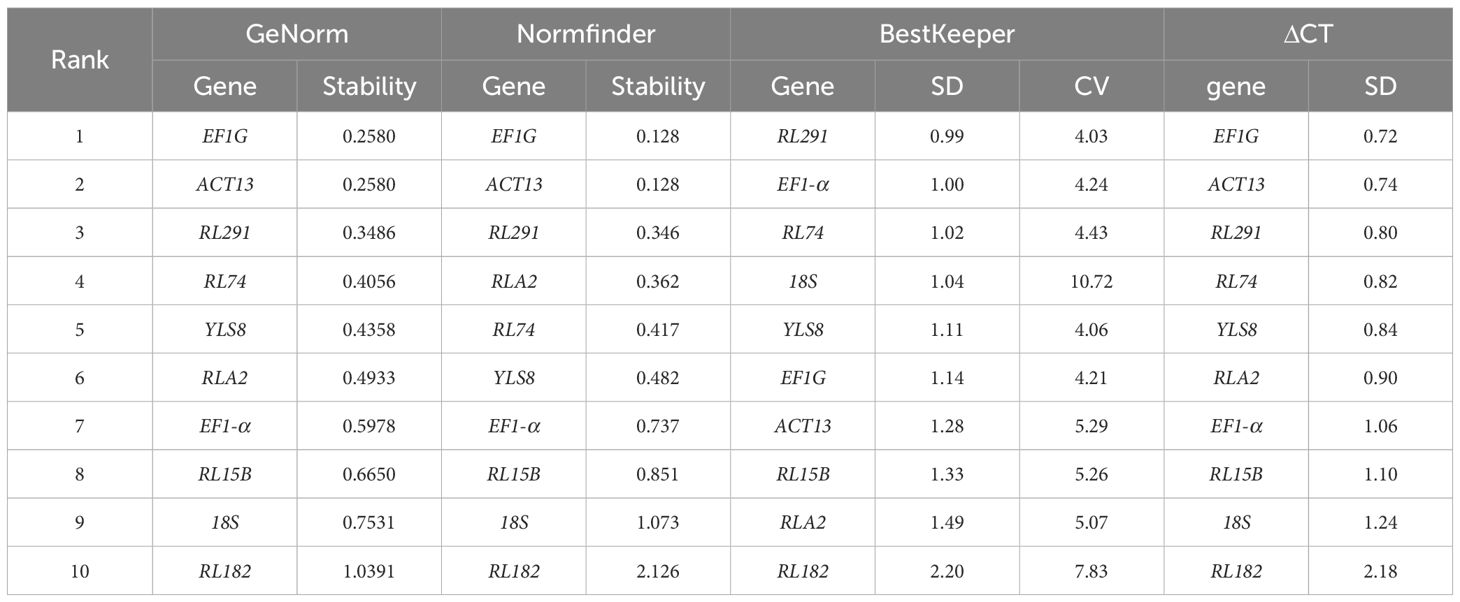
Table 2. S. davidii reference genes for normalization and their expression stability order a calculated by GeNorm, Delta CT, NormFinder and Bestkeeper.
Bestkeeper analysis
The BestKeeper software utilizes a dual methodology to evaluate gene stability. Firstly, it calculates the standard deviation (SD) and coefficient of variance (CV) of candidate genes across different samples. Then, these metrics are compared to those of a reference gene, which is selected based on its stability as indicated by its SD and CV values. Genes with SD values below 1.0 are classified as stable and are considered appropriate for normalization in gene expression studies. Specifically, genes having an SD value less than 1.0 are recognized as stable candidates for this normalization process. A lower SD value corresponds to a higher level of stability for the respective gene (Pfaffl et al., 2004). The results indicated that RL291 (0.99) and EF1-α (1.00) were identified as suitable reference genes in the seeds of S. davidii at various developmental stages (Table 2).
ΔCT analysis
The ΔCT method assesses gene expression stability by calculating the SD and CV of Ct values. Generally, lower SD and CV indicate higher expression stability (Silver et al., 2006). The results revealed that EF1G demonstrated the lowest SD value, suggesting the highest expression stability. Conversely, RL182 had the highest SD value, making it the most unstable gene (Table 2). The expression stability of the 10 candidate genes exhibited minimal variation among the statistical methods that were used. All four analytical software programs identified RL182 as the most unstable candidate gene for the S. davidii seed at various developmental stages.
Refinder analysis
ReFinder is a web-based evaluation tool that integrates the results of the previous four methods for ranking and reaches consistent results (Xie et al., 2012, 2023). This tool computes the geometric mean of each reference gene according to the rankings from four statistical methods. Generally, a lower ranking value implies higher expression stability. The results indicated that EF1G had the lowest ranking value. It was followed by RL291, ACT13, RL74, EF1-α, YLS8, RLA2, 18S, RL15B, and RL182. Among them, RL182 had the highest rank value (Table 3).
Overall, these five algorithms yielded various results when selecting the optimal reference genes for different developmental stages of seeds in S. davidii. Generally speaking, EF1G and RL291 exhibited the highest expression stability and were suitable as reference genes (Figure 4), whereas RL182 was the most unstable gene (Figure 5).
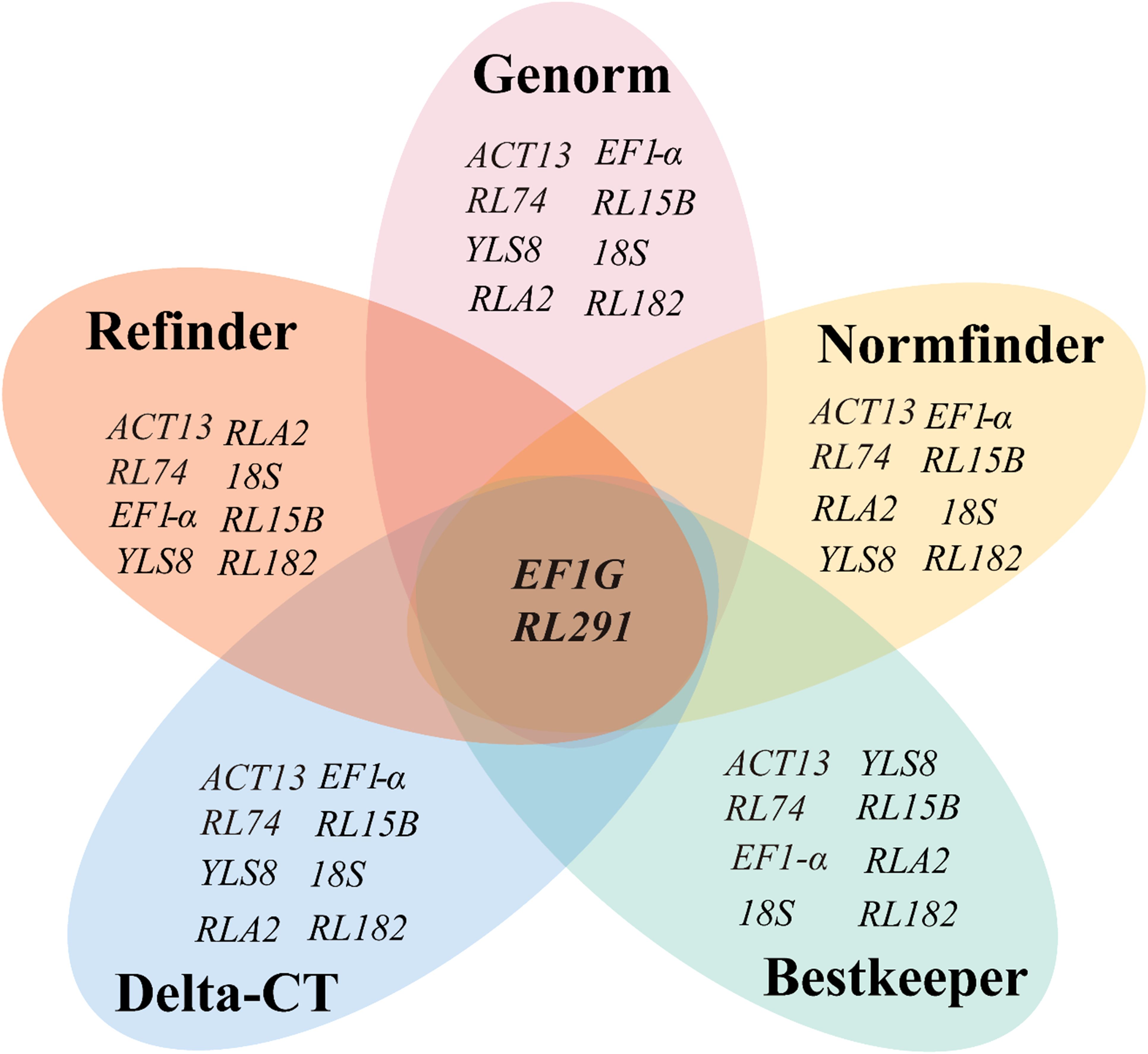
Figure 4. Venn diagram showing the most stable reference genes identified by the GeNorm, NormFinder, BestKeeper, ΔCT, and RefFinder algorithms. The intersection part reveals the most stable genes that are common among them, specifically EF1G and RL291. The mapping data were derived from Tables 2, 3.
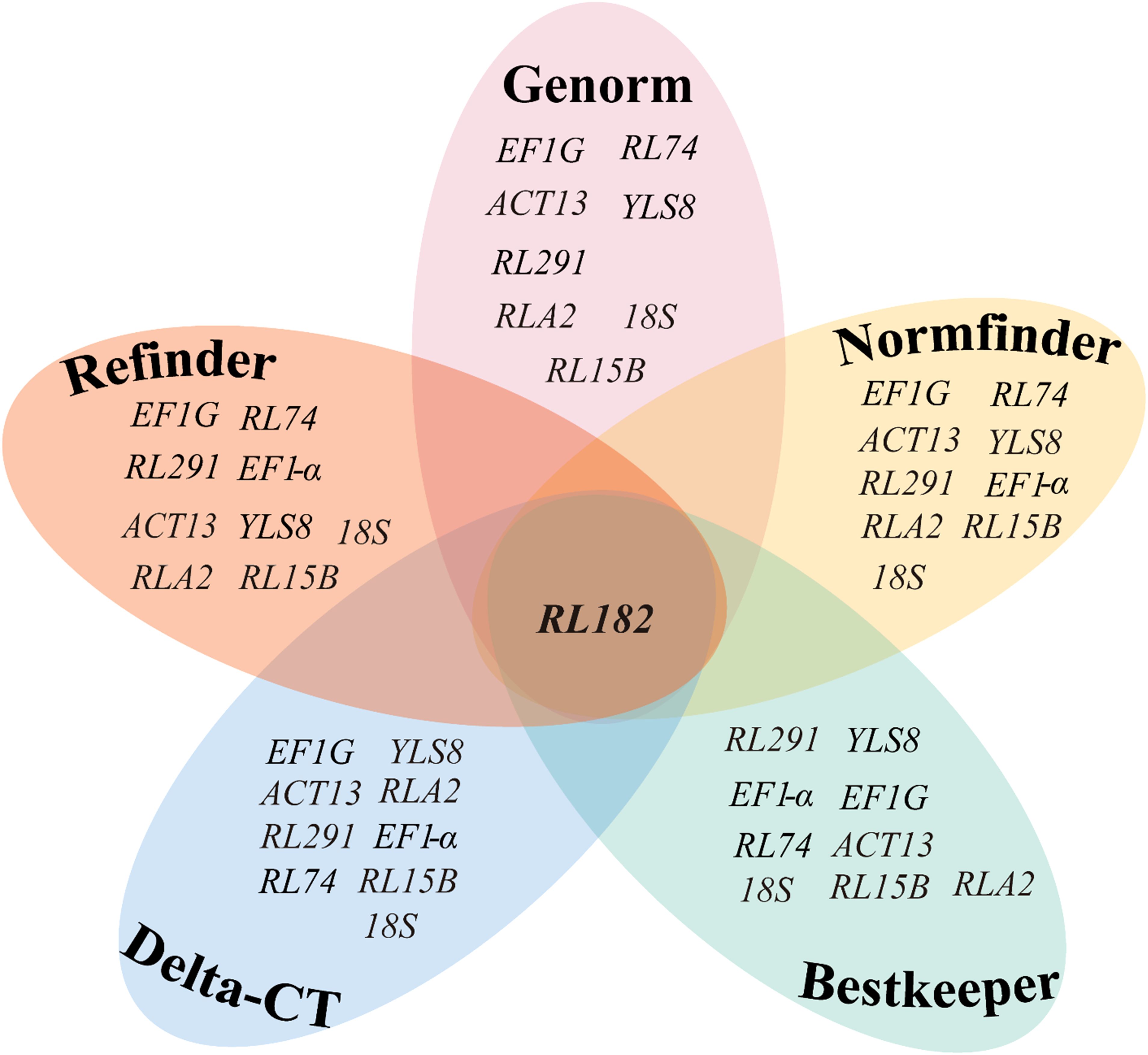
Figure 5. Venn diagram showing the least stable reference genes identified by the GeNorm, NormFinder, BestKeeper, ΔCT, and RefFinder algorithms. The intersection part reveals the most stable genes that are common among them, specifically EF1G and RL291. The mapping data were derived from Tables 2, 3.
Validation of the stability of reference genes
The results from the five algorithms indicated that the expressions of EF1G and RL291 were relatively stable. To validate the appropriateness of the identified candidate reference genes, we compared the expression patterns of target genes in the samples using FPKM-normalized RNA-seq data (Figure 6). Additionally, we confirmed these findings through a comprehensive analysis using qRT-PCR normalization.
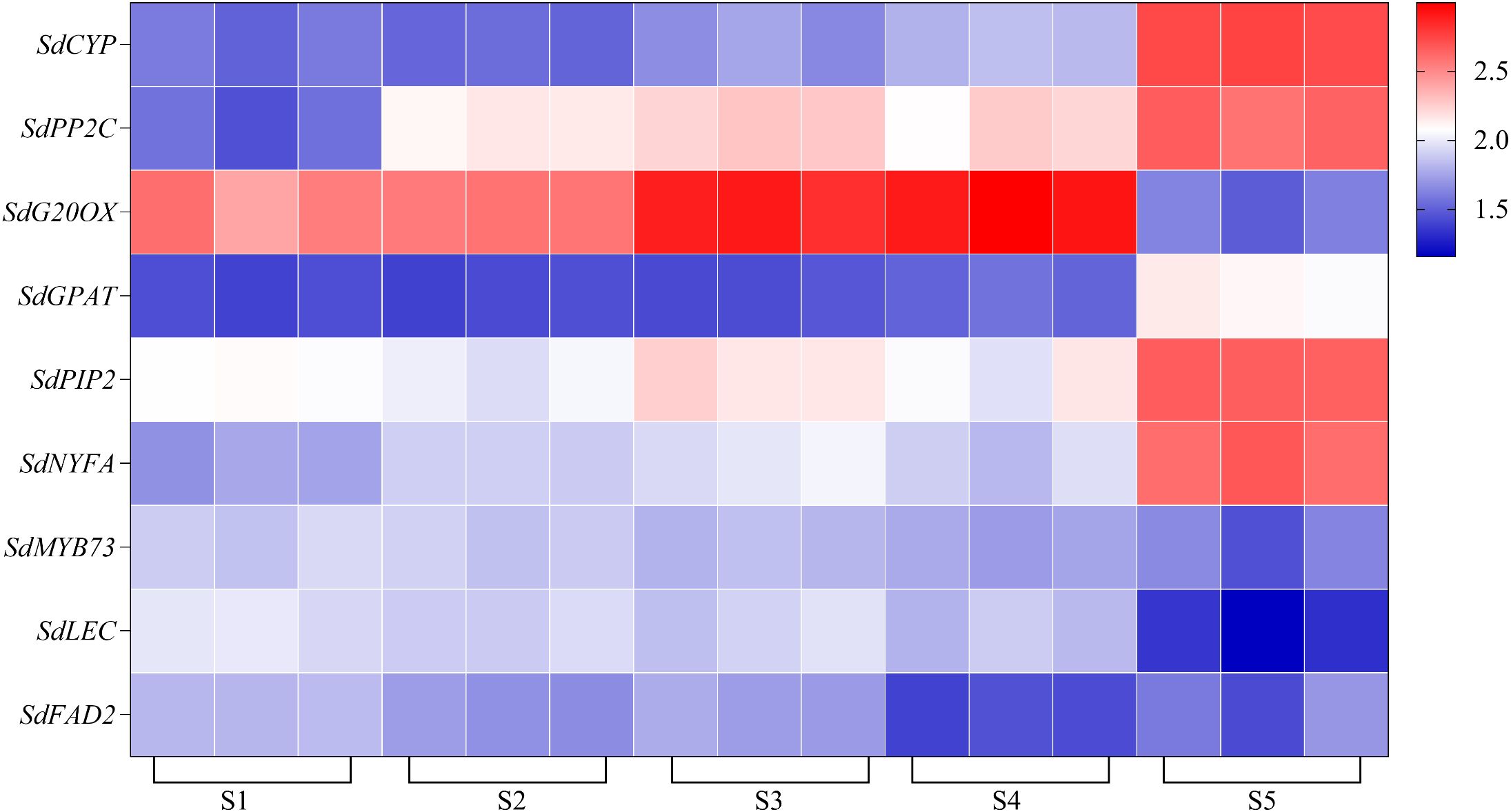
Figure 6. Heat map of the expression levels of selected key genes as likely to be involved in oil content accumulation and grain formation (SdCYP, SdFAD2, SdG20OX, SdGPAT, SdLEC, SdNYFA, SdPP2C, SdMYB73, SdPIP2).
The expression profiles of SdLDC (a functional gene related to quinsolizidine alkaloid biosynthesis) and related genes that regulate seed size and oil synthesis (FAD2, MYB73, LEC, NYFA, GA20OX, PP2C, CYP, WRKY15a, PIP) were normalized using single or multiple reference genes. The reference genes included RL291 and EF1G, either used alone or in combination, as well as the least stable internal reference gene RL182. This was done to test the reliability of the selected reference genes at different developmental stages of S. davidii seeds (Figures 7, 8). In this study, we selected the top two most stable and the least stable reference genes at different stages for normalization, combined as EF1G and RL291, for different development stages of seeds. There were variations in the expression patterns of these 10 target genes in the seeds. After standardizing the data with the top two reference genes, the expression patterns of the 10 target genes were consistent. When normalized using the lowest-ranked reference gene (RL291), the expression of the target gene was significantly higher than when using the most stable gene. The reference genes with the lowest rankings were not optimal for data normalization. When using these genes, the expression levels of target genes varied significantly compared to those obtained with the top-ranked reference genes. These results clearly indicated that the use of inappropriate reference genes could lead to misleading results in the normalization of target genes. Therefore, the results of our analysis further underscored the necessity of selecting reference genes with appropriate stability before conducting q-RT PCR studies to avoid low accuracy. In conclusion, the combination of RL291 and EF1G represents the optimal set of reference genes for the normalization of qRT-PCR data during the developmental stages of S. davidii seeds.
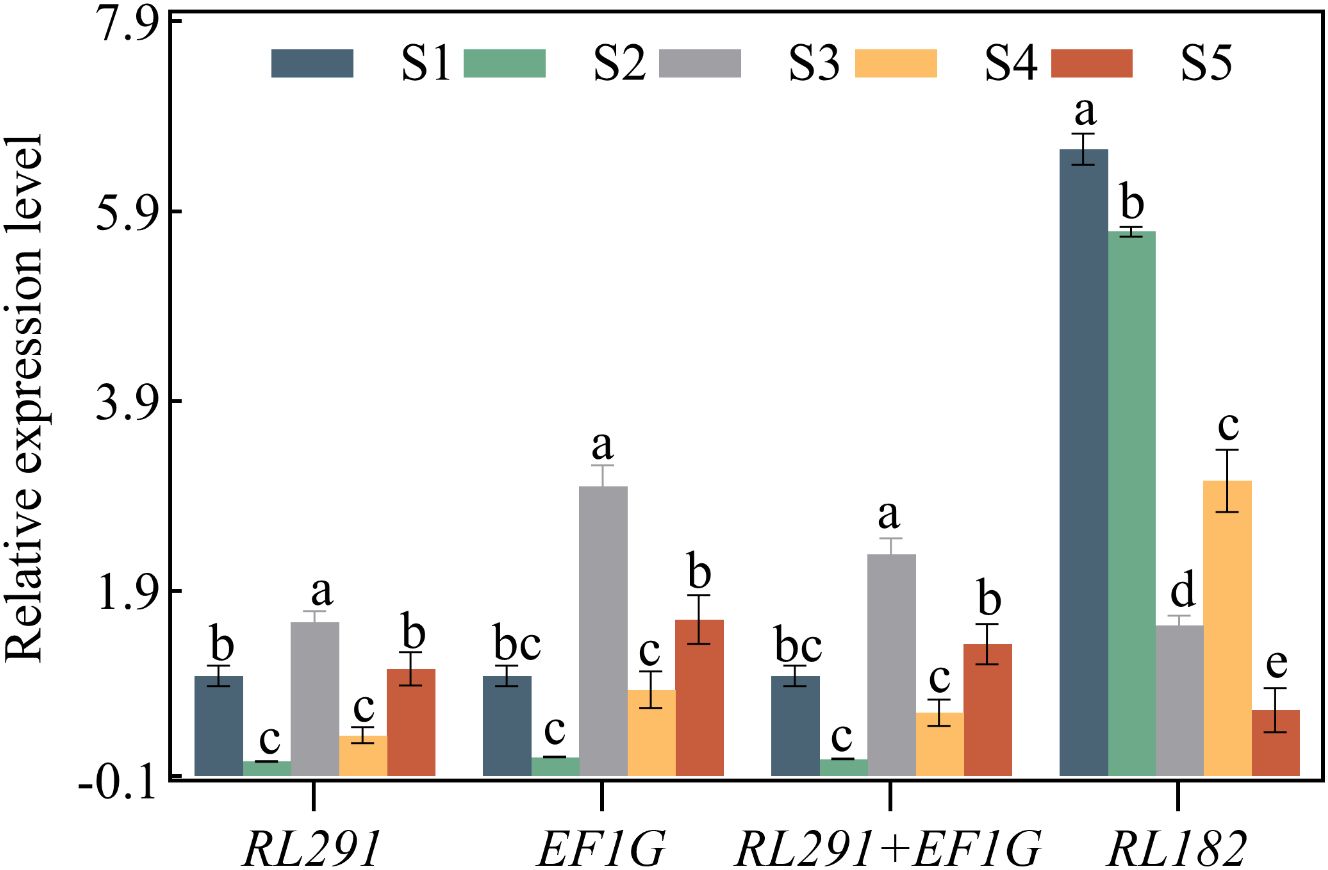
Figure 7. Validation of the identified reference genes of key genes SdLDC. Expression levels of SdLDC in different seed development stages of S. davidii. The expression data were normalized using the most stable reference genes (EF1G, RL291, and RL291+EF1G) and the least stable reference gene (RL182), respectively. The x-axis represents the comparison between the final selection of the most stable reference genes and the least stable reference gene (RL182) in the seed organ of S. davidii. Data were compared and analyzed using analysis of variance and multiple comparisons with the statistical analysis software GraphPad Prism 8.3. P<0.05 was considered to indicate a statistically significant difference.
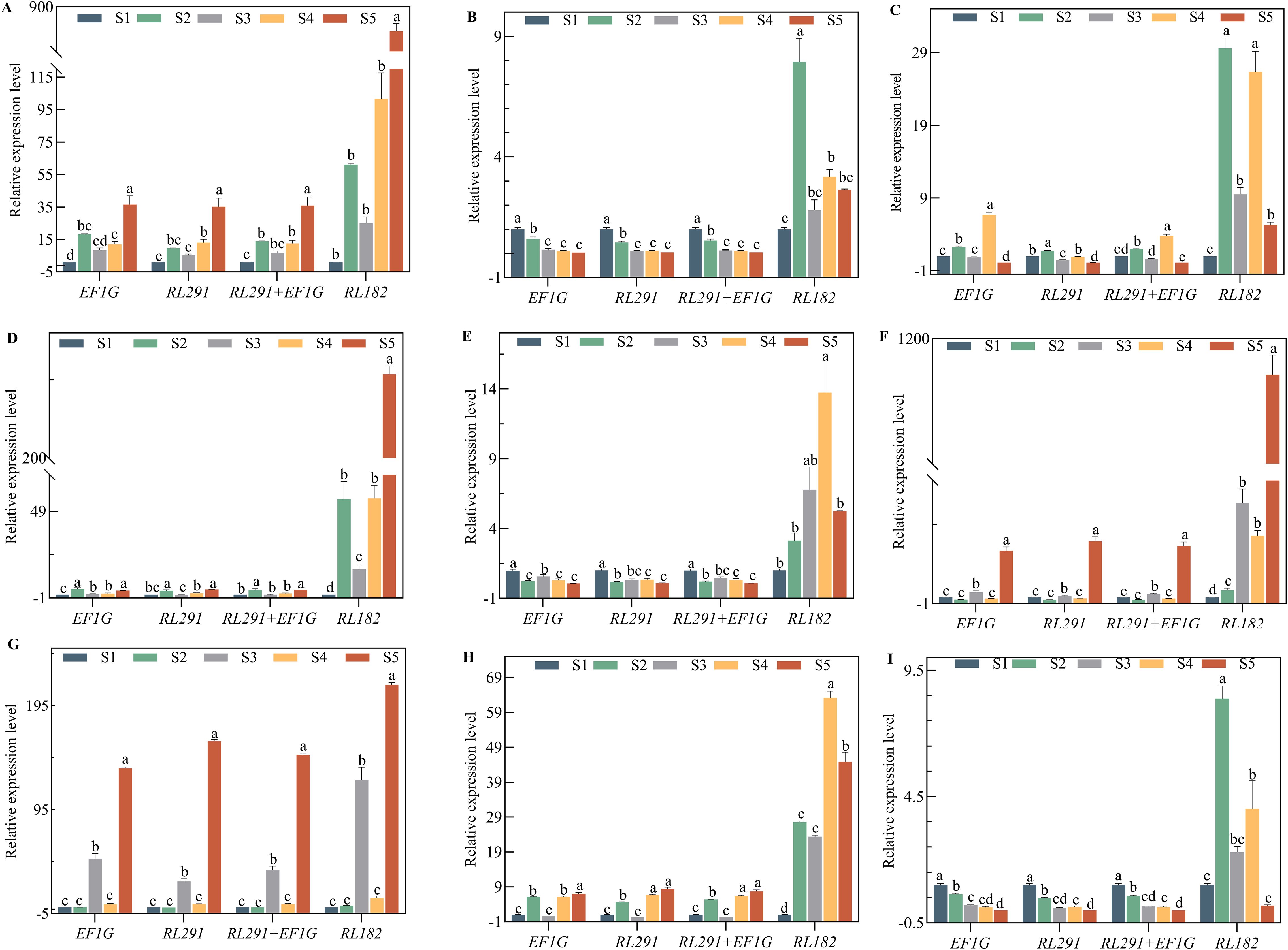
Figure 8. Validation of the identified reference genes of key genes as likely to be involved in oil content accumulation and grain formation. Expression levels of (A) SdCYP, (B) SdFDA2, (C) SdG20X1, (D) SdGPAT, (E) SdLEC, (F) SdNYFA, (G) SdPP2C, (H) SdMYB, and (I) SdPIP in different seed development stages of S. davidii. The expression data were normalized using the most stable reference genes (EF1G, RL291, and RL291+EF1G) and the least stable reference gene (RL182), respectively. The x-axis represents the comparison between the final selection of the most stable reference genes and the least stable reference gene (RL182) in the seed organ of S. davidii. Data were compared and analyzed using analysis of variance and multiple comparisons with the statistical analysis software GraphPad Prism 8.3. P<0.05 was considered to indicate a statistically significant difference.
Discussion
The critical role of reference genes in qRT-PCR normalization
Gene expression analysis is a fundamental approach for investigating regulatory pathways and metabolic activities within living organisms. qRT-PCR is a powerful technique extensively utilized in gene expression studies across a wide range of organisms, including plants, animals, and microorganisms (Zhao et al., 2024; Deepak et al., 2007; Limothai et al., 2020; Shawon et al., 2024; Yi et al., 2022; Muñoz et al., 2021). Many studies have demonstrated that no single reference gene can be effectively employed for qPCR across all species or experimental conditions. The use of stably expressed reference genes is of utmost importance for precise standardization. This practice can mitigate technical variability and ensure reliable quantification of target transcripts (França and Cerca, 2023; Liu et al., 2018). Although conventional housekeeping genes, such as actin and tubulin, are widely used, their expression stability is context-dependent and species-specific. This has been verified through studies on bacterial biofilms and plant stress responses (Zhang et al., 2022; Thellin et al., 1999). For example, Leng et al. discovered in pan-cancer platelet research that GAPDH was stably expressed in both cancerous and healthy samples, making it an ideal reference gene (Wen et al., 2022). Nevertheless, under calcium stress, the stable expression of GAPDH in HA-1 cells was disrupted, introducing systematic errors in the quantification of target genes (Suzuki et al., 2018). Vorachek et al. (2013) demonstrated that canonical reference genes, like PGK1, ACTB, and B2M, exhibited unstable expressions when neutrophils were infected, inflamed, or under stress. This poses a challenge for reliable gene expression normalization. An incorrect selection of reference genes can lead to inaccurate gene expression results (Guénin et al., 2009; Chen et al., 2019). Therefore, appropriate reference genes are the cornerstone for accurate quantification in qRT-PCR experiments, and their stability must be experimentally verified under specific conditions. In this study, improper standardization using unstable genes like RL182 led to significant variations in the expression profile of SdLDC, underscoring the necessity of rigorous validation.
Methods for evaluating reference gene stability
To minimize the bias in gene expression quantification of S. davidii, this study employed various mathematical and statistical models. Current methods for evaluating the stability of reference genes include the ΔCt, GeNorm, NormFinder, BestKeeper, and RefFinder. ΔCt assesses stability by calculating the difference in Ct values between candidate and target genes. A smaller difference indicates higher expression consistency (Silver et al., 2006). GeNorm uses pairwise comparison to compute the average logarithmic variation coefficient (M value). Genes with M values less than 1.5 are generally considered stable (Vandesompele et al., 2002). NormFinder applies analysis of variance to simulate intra- and inter-group expression variability and generates stability values for ranking reference gene candidates (Andersen et al., 2004). BestKeeper evaluates gene stability by analyzing the SD of Ct values and Pearson correlation (r) (Pfaffl et al., 2004). RefFinder integrates multiple algorithm results to produce a composite ranking, reducing method-specific bias (Xie et al., 2023). These tools evaluate stability from various angles, such as expression discrepancy, coefficient of variation, analysis of variance, and statistical correlation. Combining them can enhance the reliability of reference gene validation. However, these algorithms are not suitable for all experiments. For example, GeNorm is typically used when there are three or more candidate genes. Its results are affected by sample type and processing conditions (Vandesompele et al., 2002). Gene co-regulation may also interfere with the analysis because the software tends to select genes with similar expression profiles (Andersen et al., 2004). Therefore, it is necessary to choose an appropriate algorithm based on the experimental objectives. Among the candidate genes in this study, EF1G and RL291 ranked highly in all algorithms and showed the most stable expression. Regardless of the calculation method, RL182 was identified as the most unstable reference gene (Figures 4, 5). This highlights the importance of using multiple approaches to evaluate reference gene stability, ensuring that only the most reliable genes are selected for normalization.
The importance of RNA-seq in reference gene selection and gene expression analysis
RNA-seq is fundamental for understanding gene function and structure. It also plays a pivotal role in uncovering biological development and pathological mechanisms. Transcriptomics can help identify disease biomarkers, decipher signaling pathways, and determine therapeutic targets by comprehensively capturing dynamic gene expression patterns (Wang et al., 2009). By conducting an in-depth analysis of the whole transcriptome, researchers can identify genes that are stably expressed under specific biological conditions. This is of great significance for the selection of reliable reference genes. For instance, RNA-seq technology enabled researchers to discover the splicing pattern of introns in the organelle genome of Nymphaea species, providing new insights for reference gene selection (He et al., 2021).
In this study, we utilized multiple normalization factors, including individual genes like EF1α, RL291, RL182, and the EF1α-RL291 gene combination, to normalize the expression of several validation genes. Although the absolute values of gene abundance varied among different normalization methods, the gene expression patterns at different stages of seed development (depicted by the log-transformed FPKM values of RNA-seq) were highly consistent (Figures 6–8). Notably, using a multi-gene combination for normalization significantly improved the accuracy of the quantitative results. Conversely, using the most unstable gene, RL182, as a reference led to significant differences in the expression pattern of the validation gene (Figures 7, 8).
The significance of key gene expression analysis in biosynthetic pathway elucidation
In plant research, selecting the most appropriate reference genes is crucial for understanding gene expression and metabolic pathway regulation (Gutierrez et al., 2008). Take S. davidii for example. Its roots, leaves, flowers, and fruits are well-known for their medicinal properties. In particular, quinolizidine alkaloids like sophoridine and oxymatrine are present, which have potential therapeutic applications for various cancers (Rashid et al., 2019). However, the limited production of bioactive compounds restricts the widespread use of these plants in traditional medicine. This highlights the need to explore genetic resources for secondary metabolite biosynthesis. Although S. davidii has significant therapeutic value, little is currently known about its molecular mechanisms. Most quinolizidine alkaloids reach their highest concentration in seeds (Gotti and Clementi, 2021). Research revealed that the alkaloid content in S. davidii seeds was higher than in other tissues such as leaves and flowers (Xu et al., 2023). Therefore, in this study, samples were collected from key stages of seed development in S. davidii to investigate the expression patterns of key genes and determine the spatial specificity of enzyme-catalyzed reactions in biosynthetic pathways. The results showed that LDC, the first key enzyme in alkaloid biosynthesis, exhibited higher expression levels at the S3 stage (Figure 7). During the seed maturation stage, LDC catalyzes the decarboxylation of lysine to produce alkaloids, which play a crucial role in plant defense mechanisms and seed protection (Yang et al., 2016). The possible reason for this phenomenon is that during the seed maturation stage, LDC catalyzes the decarboxylation of lysine to produce alkaloids. These alkaloids play a vital role in the plant’s defense mechanisms and the protection of its seeds. Consequently, the high expression of LDC when the seeds are fully developed meets the demand for alkaloid synthesis.
Conclusion
In qRT-PCR, the selection of standardized and reliable internal controls is often neglected, yet it is a critical factor directly influencing the rigor of gene expression analysis. Although qRT-PCR is widely used for quantifying relative gene expression, the accuracy of results may decline if stable reference genes are not carefully chosen, thereby undermining data reliability. Therefore, identifying and validating appropriate reference genes is essential to ensure the accuracy of gene expression measurements.
This study aimed to identify reliable reference genes for qRT-PCR of S. davidii seeds, which is significant for understanding quinolizidine alkaloid biosynthesis. By conducting transcriptome-guided screening and validating with multiple algorithms (GeNorm, NormFinder, BestKeeper, ΔCT, and RefFinder), we identified that EF1G and RL291 are the optimal reference genes for normalizing qRT-PCR data at five distinct morphological stages of seed development. The reliability of these genes was verified through qRT-PCR and various analytical methods. These findings provide a solid foundation for accurate gene expression analysis of S. davidii, particularly in investigating alkaloid biosynthetic pathways. This research underscores the importance of transcriptome sequencing in selecting the optimal reference genes and paves the way for further research on key enzymes in the alkaloid biosynthesis of S. davidii.
Data availability statement
The raw data supporting the conclusions of this article will be made available by the authors, without undue reservation.
Author contributions
JJL: Writing – original draft, Writing – review & editing, Visualization. SH: Writing – review & editing, Data curation. ZX: Formal Analysis, Writing – review & editing. BD: Validation, Writing – review & editing. NZ: Data curation, Writing – review & editing. YS: Methodology, Writing – review & editing. ZQ: Writing – review & editing, Resources. YY: Writing – review & editing, Resources. HZ: Validation, Writing – review & editing. ZL: Validation, Writing – review & editing. JL: Funding acquisition, Writing – original draft. SL: Funding acquisition, Writing – review & editing.
Funding
The author(s) declare that financial support was received for the research and/or publication of this article. This research was financially supported by Shaanxi Provincial special fund for Chinese medicine (2021-QYZL-01, 2021-QYZL-03), Key Research and Development Program of Shaanxi (2023-YBSF-491), General project of Chinese Medicine Administration of Shaanxi Province (SZY-KJCYC-2023-026).
Conflict of interest
The authors declare that the research was conducted in the absence of any commercial or financial relationships that could be construed as a potential conflict of interest.
Publisher’s note
All claims expressed in this article are solely those of the authors and do not necessarily represent those of their affiliated organizations, or those of the publisher, the editors and the reviewers. Any product that may be evaluated in this article, or claim that may be made by its manufacturer, is not guaranteed or endorsed by the publisher.
Supplementary material
The Supplementary Material for this article can be found online at: https://www.frontiersin.org/articles/10.3389/fpls.2025.1485586/full#supplementary-material
References
Al Amin, N., Ahmad, N., Wu, N., Pu, X. M., Ma, T., Du, Y. Y., et al. (2019). CRISPR-Cas9 mediated targeted disruption of FAD2–2 microsomal omega-6 desaturase in soybean (Glycine max.L). BMC biotech. 19, 9. doi: 10.1186/s12896-019-0501-2
Andersen, C. L., Jensen, J. L., and Ørntoft, T. F. (2004). Normalization of real-time quantitative reverse transcription-PCR data: a model-based variance estimation approach to identify genes suited for normalization, applied to bladder and colon cancer data sets. Cancer Res. 64, 5245–5250. doi: 10.1158/0008-5472.Can-04-0496
Bowen, J., Ireland, H. S., Crowhurst, R. N., Luo, Z. W., Watson, A., Foster, T., et al. (2014). Selection of low-variance expressed Malus x domestica (apple) genes for use as quantitative PCR reference genes (housekeepers). Tree Genet. Genomes. 10, 751–759. doi: 10.1007/s11295-014-0720-6
Bunsupa, S., Yamazaki, M., and Saito, K. (2012). Quinolizidine alkaloid biosynthesis: recent advances and future prospects. Front. Plant Sci. 3. doi: 10.3389/fpls.2012.00239
Chen, S. X., Chen, M. F., Qian, F. R., and Xie, L. S. (2005). A Clinical research of Sophocarpine in treatment of viral myocarditis. J. Clin. Cardiol. 10, 608–611.
Chen, Z. W., Halford, N. G., and Liu, C. H. (2023). Real-time quantitative PCR: primer design, reference gene selection, calculations and statistics. Metabolites. 13, 806. doi: 10.3390/metabo13070806
Chen, C., Wu, J. Y., Hua, Q. Z., Tel-Zur, N., Xie, F. F., Zhang, Z. K., et al. (2019). Identification of reliable reference genes for quantitative real-time PCR normalization in pitaya. Plant Methods. 15, 70. doi: 10.1186/s13007-019-0455-3
Chen, C. M., Yuan, M., Song, J. J., Liu, Y. Y., Xia, Z. H., Yuan, Y. F., et al. (2020). Genome-wide identification and testing of superior reference genes for transcript normalization during analyses of flesh development in Asian pear cultivars. Sci. Hortic. 271, 109459. doi: 10.1016/j.scienta.2020.109459
Deepak, S., Kottapalli, K., Rakwal, R., Oros, G., Rangappa, K., Iwahashi, H., et al. (2007). Real-time PCR: revolutionizing detection and expression analysis of genes. Curr. Genomics 8, 234–251. doi: 10.2174/138920207781386960
Fazzina, M., Bergonzoni, M., Massenzio, F., Monti, B., Frabetti, F., and Casadei, R. (2024). Selection of suitable reference genes for gene expression studies in HMC3 cell line by quantitative real-time RT-PCR. Sci. Rep. 14, 2431. doi: 10.1038/s41598-024-52415-7
Ferreira, M. J., Jessy, S., Sara, C. P., and Sílvia, C. (2023). I Choose You: Selecting Accurate Reference Genes for qPCR Expression Analysis in Reproductive Tissues in Arabidopsis thaliana. Biomolecules. 13, 463. doi: 10.3390/biom13030463
França, Â. and Cerca, N. (2023). Gene expression quantification from pathogenic bacterial biofilms by quantitative PCR. Methods Mol. Biol. 2967, 133–149. doi: 10.1007/978-1-0716-3358-8_11
Freitas, B. L., Leach, L., Chaturvedi, V., and Chaturvedi, S. (2021). Reverse Transcription-Quantitative real-time PCR (RT-qPCR) Assay for the Rapid Enumeration of Live Candida auris from the Healthcare Environment. J. Clin. Microbiol. 60, e0077921. doi: 10.1128/jcm.00779-21
Ginzinger, D. G. (2002). Gene quantification using real-time quantitative PCR: an emerging technology hits the mainstream. Exp. Hematol. 30, 503–512. doi: 10.1016/s0301-472x(02)00806-8
Gotti, C. and Clementi, F. (2021). Cytisine and cytisine derivatives. More than smoking cessation aids. Pharmacol. Res. 170, 105700. doi: 10.1016/j.phrs.2021.105700
Guénin, S., Mauriat, M., Pelloux, J., Van Wuytswinkel, O., Bellini, C., and Gutierrez, L. (2009). Normalization of qRT-PCR data: the necessity of adopting a systematic, experimental conditions-specific, validation of references. J. Exp. Bot. 60, 487–493. doi: 10.1093/jxb/ern305
Gutierrez, L., Mauriat, M., Guénin, S., Pelloux, J., Lefebvre, J. F., Louvet, R., et al. (2008). The lack of a systematic validation of reference genes: a serious pitfall undervalued in reverse transcription-polymerase chain reaction (RT-PCR) analysis in plants. Plant Biotechnol. J. 6, 609–618. doi: 10.1111/j.1467-7652.2008.00346.x
He, Z. S., Zhu, A. D., Yang, J. B., Fan, W. S., and Li, D. Z. (2021). Organelle genomes and transcriptomes of nymphaea reveal the interplay between intron splicing and RNA editing. Int. J. Mol. Sci. 22, 9842. doi: 10.3390/ijms22189842
Hirawake-Mogi, H., Nguyen, T. T. N., and Okuwaki, M. (2021). G-patch domain-containing protein 4 localizes to both the nucleoli and Cajal bodies and regulates cell growth and nucleolar structure. Biochem. Biophys. Res. Commun. 559, 99–105. doi: 10.1016/j.bbrc.2021.04.026
Hu, Y., Jiang, Q., Zhai, X., Liu, L., and Hong, Y. T. (2023). Screening and validation of the optimal panel of reference genes in colonic epithelium and relative cancer cell lines. Sci. Rep. 13, 17777. doi: 10.1038/s41598-023-45174-4
Hu, A. S., Yang, X. Y., Zhu, J. F., Wang, X. P., Liu, J. X., Wang, J. P., et al. (2022). Selection and validation of appropriate reference genes for RT-qPCR analysis of Nitraria sibirica under various abiotic stresses. BMC Plant Biol. 22, 592. doi: 10.1186/s12870-022-03988-w
Hu, X. W., Zhang, L. J., Nan, S. Z., Miao, X. M., Yang, P. F., Duan, G. Q., et al. (2018). Selection and validation of reference genes for quantitative real-time PCR in Artemisia sphaerocephala based on transcriptome sequence data. Gene 657, 39–49. doi: 10.1016/j.gene.2018.03.004
Huggett, J., Dheda, K., Bustin, S., and Zumla, A. (2005). Real-time RT-PCR normalisation; strategies and considerations. Genes Immun. 6, 279–284. doi: 10.1038/sj.gene.6364190
Kubista, M., Andrade, J. M., Bengtsson, M., Forootan, A., Jonák, J., Lind, K., et al. (2006). The real-time polymerase chain reaction. Mol. Aspects Med. 27, 95–125. doi: 10.1016/j.mam.2005.12.007
Li, F. L., Bao, W. K., and Wu, N. (2009). Effects of water stress on growth, dry matter allocation and water-use efficiency of a leguminous species, Sophora davidii. Agrofor. Syst. 77, 193–201. doi: 10.1007/s10457-008-9199-1
Li, J. T., Han, X. P., Wang, C., Qi, W. Z., Zhang, W. Y., Tang, L., et al. (2017). Validation of Suitable Reference Genes for RT-qPCR Data in Achyranthes bidentata Blume under Different Experimental Conditions. Front. Pant. Sci. 8. doi: 10.3389/fpls.2017.00776
Li, Y. M., Qu, Y., Wang, Y., Bai, X., Tian, G., Liu, Z. R., et al. (2019). Selection of suitable reference genes for qRT-PCR analysis of Begonia semperflorens under stress conditions. Mol. Biol. Rep. 46, 6027–6037. doi: 10.1007/s11033-019-05038-5
Li, M. Y., Wang, F., Jiang, Q., Wang, G. L., Tian, C., and Xiong, A. S. (2016). Validation and Comparison of Reference Genes for qPCR Normalization of Celery (Apium graveolens) at Different Development Stages. Front. Plant Sci. 7. doi: 10.3389/fpls.2016.00313
Li, Y., Wang, G., Liu, J., and Ouyang, L. (2020). Quinolizidine alkaloids derivatives from Sophora alopecuroides Linn: Bioactivities, structure-activity relationships and preliminary molecular mechanisms. Eur. J. Med. Chem. 188, 111972. doi: 10.1016/j.ejmech.2019.111972
Li, T., Wang, J., Lu, M., Zhang, T. Y., Qu, X. Y., and Wang, Z. Z. (2017). Selection and Validation of Appropriate Reference Genes for qRT-PCR Analysis in Isatis indigotica Fort. Front. Plant Sci. 8. doi: 10.3389/fpls.2017.01139
Li, J. L., Wei, S. J., Marabada, D., Wang, Z. Z., and Huang, Q. (2023). Research progress of natural matrine compounds and synthetic matrine derivatives. Mol. (Basel Switzerland). 28, 5780. doi: 10.3390/molecules28155780
Liang, L. J., He, Z. G., Yu, H. Z., Wang, E. H., Zhang, X. J., Zhang, B. X., et al. (2020). Selection and validation of reference genes for gene expression studies in codonopsis pilosula based on transcriptome sequence data. Sci. Rep. 10, 1362. doi: 10.1038/s41598-020-58328-5
Limothai, U., Chuaypen, N., Poovorawan, K., Chotiyaputta, W., Tanwandee, T., Poovorawan, Y., et al. (2020). Reverse transcriptase droplet digital PCR vs reverse transcriptase quantitative real-time PCR for serum HBV RNA quantification. J. Med. Virol. 92, 3365–3372. doi: 10.1002/jmv.25792
Lin, B. B., Liu, X., Wu, S. Q., Zheng, H. X., Huo, K. K., Qi, S. S., et al. (2019). Phytochemicals content, antioxidant and antibacterial activities of sophora viciifolia. Chem. Biodivers. 16, e1900080. doi: 10.1002/cbdv.201900080
Liu, X., Guan, H. R., Song, M., Fu, Y. P., Han, X. M., Lei, M., et al. (2018). Reference gene selection for qRT-PCR assays in Stellera chamaejasme subjected to abiotic stresses and hormone treatments based on transcriptome datasets. Peer J. 6, e4535. doi: 10.7717/peerj.4535
Liu, Y. F., Li, Q. T., Lu, X., Song, Q. X., Lam, S. M., Zhang, W. K., et al. (2014). Soybean GmMYB73 promotes lipid accumulation in transgenic plants. BMC Plant Biol. 14, 73. doi: 10.1186/1471-2229-14-73
Livak, K. J. and Schmittgen, T. D. (2001). Analysis of relative gene expression data using real-time quantitative PCR and the 2(-Delta Delta C(T)) Method. Methods 25, 402–408. doi: 10.1006/meth.2001.1262
Lu, L. H., Dong, C. H., Liu, R. F., Zhou, B., Wang, C., and Shou, H. X. (2018). Roles of soybean plasma membrane intrinsic protein gmPIP2;9 in drought tolerance and seed development. Front. Plant Sci. 9. doi: 10.3389/fpls.2018.00530
Lu, X., Li, Q. T., Xiong, Q., Li, W., Bi, Y. D., Lai, Y. C., et al. (2016). The transcriptomic signature of developing soybean seeds reveals the genetic basis of seed trait adaptation during domestication. Plant J. 86, 530–544. doi: 10.1111/tpj.13181
Lu, X., Xiong, Q., Cheng, T., Li, Q. T., Liu, X. L., Bi, Y. D., et al. (2017). A PP2C-1 allele underlying a quantitative trait locus enhances soybean 100-seed weight. Mol. Plant 10, 670–684. doi: 10.1016/j.molp.2017.03.006
Lucho, S. R., do Amaral, M. N., Benitez, L. C., Milech, C., Kleinowski, A. M., Bianchi, V. J., et al. (2018). Validation of reference genes for RT-qPCR studies in Stevia rebaudiana in response to elicitor agents. Physiol. Mol. Biol. Plants. 24, 767–779. doi: 10.1007/s12298-018-0583-7
Majewski, J. and Pastinen, T. (2011). The study of eQTL variations by RNA-seq: from SNPs to phenotypes. Trends Genet. 27, 72–79. doi: 10.1016/j.tig.2010.10.006
Manan, S., Ahmad, M. Z., Zhang, G. Y., Chen, B. B., Haq, B. U., Yang, J. H., et al. (2017). Soybean LEC2 regulates subsets of genes involved in controlling the biosynthesis and catabolism of seed storage substances and seed development. Front. Plant Sci. 8. doi: 10.3389/fpls.2017.01604
Mancinotti, D., Frick, K. M., and Geu-Flores, F. (2022). Biosynthesis of quinolizidine alkaloids in lupins: mechanistic considerations and prospects for pathway elucidation. Nat. Prod. Rep. 39, 1423–1437. doi: 10.1039/d1np00069a
Meng, H., Yang, Y., Gao, Z. H., and Wei, J. H. (2019). Selection and validation of reference genes for gene expression studies by RT-PCR in dalbergia odorifera. Sci. Rep. 9, 3341. doi: 10.1038/s41598-019-39088-3
Muñoz, J. J., Anauate, A. C., Amaral, A. G., Ferreira, F. M., Watanabe, E. H., Meca, R., et al. (2021). Ppia is the most stable housekeeping gene for qRT-PCR normalization in kidneys of three Pkd1-deficient mouse models. Sci. Rep. 11, 19798. doi: 10.1038/s41598-021-99366-x
Panina, Y., Germond, A., Masui, S., and Watanabe, T. M. (2018). Validation of Common Housekeeping Genes as Reference for qPCR Gene Expression Analysis During iPS Reprogramming Process. Sci. Rep. 8, 8716. doi: 10.1038/s41598-018-26707-8
Pfaffl, M. W., Tichopad, A., Prgomet, C., and Neuvians, T. P. (2004). Determination of stable housekeeping genes, differentially regulated target genes and sample integrity: BestKeeper–Excel-based tool using pair-wise correlations. Biotechnol. Lett. 26, 509–515. doi: 10.1023/b:bile.0000019559.84305.47
Radonić, A., Thulke, S., Mackay, I. M., Landt, O., Siegert, W., and Nitsche, A. (2004). Guideline to reference gene selection for quantitative real-time PCR. Biochem. Biophys. Res. Commun. 313, 856–862. doi: 10.1016/j.bbrc.2003.11.177
Rashid, H. U., Xu, Y. M., Muhammad, Y., Wang, L. S., and Jiang, J. (2019). Research advances on anticancer activities of matrine and its derivatives: An updated overview. Eur. J. Med. Chem. 161, 205–238. doi: 10.1016/j.ejmech.2018.10.037
Remans, T., Keunen, E., Bex, G. J., Smeets, K., Vangronsveld, J., and Cuypers, A. (2014). Reliable gene expression analysis by reverse transcription-quantitative PCR: reporting and minimizing the uncertainty in data accuracy. Plant Cell. 26, 3829–3837. doi: 10.1105/tpc.114.130641
Schmidt, G. W. and Delaney, S. K. (2010). Stable internal reference genes for normalization of real-time RT-PCR in tobacco (Nicotiana tabacum) during development and abiotic stress. Mol. Genet. Genomics. 283, 233–241. doi: 10.1007/s00438-010-0511-1
Shawon, J., Pell, L. G., Kabir, M., Evans, K., Hasan, M., Li, G., et al. (2024). Detection and absolute quantification of Lactiplantibacillus plantarum ATCC 202195 by quantitative real-time PCR. Microbiol. Spectr. 12, e0271123. doi: 10.1128/spectrum.02711-23
Silver, N., Best, S., Jiang, J., and Thein, S. L. (2006). Selection of housekeeping genes for gene expression studies in human reticulocytes using real-time PCR. BMC Mol. Biol. 7, 33. doi: 10.1186/1471-2199-7-33
Stanton, K. A., Edger, P. P., Puzey, J. R., Kinser, T., Cheng, P., Vernon, D. M., et al. (2017). A whole-transcriptome approach to evaluating reference genes for quantitative gene expression studies: A case study in mimulus. G3 (Bethesda Md.). 7, 1085–1095. doi: 10.1534/g3.116.038075
Suzuki, T., Higgins, P. J., and Crawford, D. R. (2018). Control selection for RNA quantitation. BioTechniques 29, 332–337. doi: 10.2144/00292rv02
Tai, Z. G., Cai, L., Dai, L., Dong, L. H., Wang, M. F., Yang, Y. B., et al. (2011). Antioxidant activity and chemical constituents of edible flower of Sophora viciifolia. Food Chem. 126, 1648–1654. doi: 10.1016/j.foodchem.2010.12.048
Thellin, O., Zorzi, W., Lakaye, B., De Borman, B., Coumans, B., Hennen, G., et al. (1999). Housekeeping genes as internal standards: use and limits. J. Biotechnol. 75, 291–295. doi: 10.1016/s0168-1656(99)00163-7
Vandesompele, J., Preter, K. D., Pattyn, F., Poppe, B., Roy, N. V., Paepe, A. D., et al. (2002). Accurate normalization of real-time quantitative RT-PCR data by geometric averaging of multiple internal control genes. Genome Biol. 3, research0034.1. doi: 10.1186/gb-2002-3-7-research0034
Vijayakumar, S. and Sakuntala, M. (2024). Validation of reference gene stability for normalization of RT-qPCR in Phytophthora capsici Leonian during its interaction with Piper nigrum L. Sci. Rep. 14, 7331. doi: 10.1038/s41598-024-58139-y
Vorachek, W. R., Hugejiletu, Bobe, G., and Hall, J. A. (2013). Reference gene selection for quantitative PCR studies in sheep neutrophils. Int. J. Mol. Sci. 14, 11484–11495. doi: 10.3390/ijms140611484
Wang, M. and Bhullar, N. K. (2021). Selection of suitable reference genes for qRT-PCR gene expression studies in rice. Methods Mol. Biol. 2238, 293–312. doi: 10.1007/978-1-0716-1068-8_20
Wang, Z., Gerstein, M., and Snyder, M. (2009). RNA-Seq: a revolutionary tool for transcriptomics. Nat. Rev. Genet. 10, 57–63. doi: 10.1038/nrg2484
Wang, X. B., Li, Y. H., Zhang, H. W., Sun, G. L., Zhang, W. M., and Qiu, L. J. (2015). Evolution and association analysis of GmCYP78A10 gene with seed size/weight and pod number in soybean. Mol. Biol. Rep. 42, 489–496. doi: 10.1007/s11033-014-3792-3
Wang, F. L., Wang, H., Wang, J. H., Wang, D. X., Gao, Y., Yang, B., et al. (2021). Analgesic and anti-inflammatory activities of sophocarpine from sophora viciifolia hance. BioMed. Res. Int. 2021, 8893563. doi: 10.1155/2021/8893563
Wang, H. Q., Xia, C. B., Chen, L., Zhao, J. J., Tao, W. W., Zhang, X., et al. (2019). Phytochemical information and biological activities of quinolizidine alkaloids in sophora: A comprehensive review. Curr. Drug Targets. 20, 1572–1586. doi: 10.2174/1389450120666190618125816
Wang, L. L. and Yilihamu, Y. (2021). Prrediction of potential suitable areas for a Chinese endemic shrub Sophora davidii using the MaxEnt Model. Chin. J. Ecol. 40, 3114–3124. doi: 10.13292/j.1000-4890.202110.024
Wang, Z. Y., Zu, T. H., Huang, X. Z., Jiang, X. L., Jia, G. Q., Xu, J. Z., et al. (2023). Comprehensive investigation of the content and the origin of matrine-type alkaloids in Chinese honeys. Food Chem. 402, 134254. doi: 10.1016/j.foodchem.2022.134254
Wen, X. X., Yang, G. G., Dong, Y. C., Luo, L. P., Cao, B. R., Mengesha, B. A., et al. (2022). Selection and validation of reference genes for pan-cancer in platelets based on RNA-sequence data. Front. Genet. 13. doi: 10.3389/fgene.2022.9138846
Wink, M. (2019). Quinolizidine and pyrrolizidine alkaloid chemical ecology - a mini-review on their similarities and differences. J. Chem. Ecol. 45, 109–115. doi: 10.1007/s10886-018-1005-6
Xie, F., Wang, J. Y., and Zhang, B. H. (2023). RefFinder: a web-based tool for comprehensively analyzing and identifying reference genes. Funct. Integr. Genomics 23, 125. doi: 10.1007/s10142-023-01055-7
Xie, F. L., Xiao, P., Chen, D. L., Xu, L., and Zhang, B. H. (2012). miRDeepFinder: a miRNA analysis tool for deep sequencing of plant small RNAs. Plant Mol. Biol. 80, 75–84. doi: 10.1007/s11103-012-9885-2
Xu, Z. R., Liu, Y., Liu, S., Deng, B., Zhi, W. B., Zhang, H., et al. (2024). Study on quality standard of Sophora davidii seed. J. Chin. Med. Mater., 1203–1207. doi: 10.13863/j.issn1001-4454.2024.05.022
Xu, Z. R., Liu, Y., Liu, S., Zhi, W. B., Jiang, S. N., Li, Y., et al. (2023). Research progress on the chemical constituents, quality standard and pharmacological action of sophora davidii. Chin. Wild Plant Res. 42, 70–78. doi: 10.13863/j.issn1001-4454.2024.05.022
Yang, Y., Lu, S. S., Liu, P., and Tian, L. (2016). Cloning and expression analysis of a lysine decarboxylase gene in Sophora alopecuroides. Acta Pratacult. Sci. 25, 128–135. doi: 10.11686/cyxb2015477
Yi, S. Y., Lu, H. B., Tian, C. J., Xu, T., Song, C., Wang, W., et al. (2022). Selection of suitable reference genes for gene expression normalization studies in dendrobium huoshanense. Genes 13, 1486. doi: 10.3390/genes13081486
Yim, A. K. Y., Wong, J. W. H., Ku, Y. S., Qin, H., Chan, T. F., and Lam, H. M. (2015). Using RNA-seq data to evaluate reference genes suitable for gene expression studies in soybean. PloS One 10, e0136343. doi: 10.1371/journal.pone.0136343
Zhang, Z. J., Dong, S. W., Gao, D. D., Du, X. Y., Xie, Y. Q., Xia, X. S., et al. (2021). Unusual matrine-adenine hybrids isolated from Sophora davidii and their inhibitory effects on human cytomegalovirus. Phytochem 190, 112842. doi: 10.1016/j.phytochem.2021.112842
Zhang, Q. Y., Liu, C. L., Yu, X. J., Yang, J. D., and Fen, C. N. (2022). Screening of Reference Genes for Differentially Expressed Genes in Pyrus betulaefolia Plant Under Salt Stress by qRT-PCR. Acta Hortic. Sinica. 49, 1557–1570. doi: 10.16420/j.issn.0513-353x.2021-0376
Zhang, Y. B., Luo, D., Yang, L., Cheng, W., He, L. J., Kuang, G. K., et al. (2018). Matrine-Type Alkaloids from the Roots of Sophora flavescens and Their Antiviral Activities against the Hepatitis B Virus. J. Nat. Prod. 81, 2259–2265. doi: 10.1021/acs.jnatprod.8b00576
Zhang, B. C., Sun, Z. Q., Lv, M., and Xu, H. (2018). Semisynthesis of Matrinic Acid/Alcohol/Ester Derivatives, Their Pesticidal Activities, and Investigation of Mechanisms of Action against Tetranychus cinnabarinus. J. Agric. Food Chem. 66, 12898–12910. doi: 10.1021/acs.jafc.8b04965
Zhang, T., Tian, C. Y., Zhang, J., An, Q., Yi, P., Yuan, C. M., et al. (2024). Quinolizidine alkaloids and isoflavones from the herb of thermopsis lupinoides and their antiviral, antifungal, and insecticidal activities. J. Agric. Food Chem. 72, 5047–5061. doi: 10.1021/acs.jafc.3c09529
Zhao, X. D., Geng, Y. S., Hu, T. Y., Zhao, Y. G., Yang, S. L., and Hao, D. J. (2022). Evaluation of Optimal Reference Genes for qRT-PCR Analysis in Hyphantria cunea (Drury). Insects 13, 97. doi: 10.3390/insects13010097
Zhao, W., Tian, Y., Wang, Y., Wu, Y., Ren, Z. M., and Li, K. H. (2024). Selection of reference genes for quantitative real-time PCR analysis in exogenous hormone-treated Lycoris aurea. Acta Biochim. Biophys. Sin. (Shanghai). 57, 671–675. doi: 10.3724/abbs.2024197
Zhao, J. M., Yang, J., Wang, X. Y., Xiong, Y. L., Xiong, Y., Dong, Z. X., et al. (2022). Selection and Validation of Reference Genes for qRT-PCR Gene Expression Analysis in Kengyilia melanthera. Genes 13, 1445. doi: 10.3390/genes13081445
Zheng, T. C., Chen, Z. L., Ju, Y. Q., Zhang, H., Cai, M., Pan, H. T., et al. (2018). Reference gene selection for qRT-PCR analysis of flower development in Lagerstroemia indica and L. speciosa. PloS One 13, e0195004. doi: 10.1371/journal.pone.0195004
Zhou, W., Wang, S. Q., Yang, L., Sun, Y., Zhang, Q., Li, B., et al. (2019). Reference genes for qRT-PCR normalisation in different tissues, developmental stages, and stress conditions of Hypericum perforatum. Peer J. 7, e7133. doi: 10.7717/peerj.7133
Keywords: Sophora davidii, reference gene, development stages of seeds, stability, normalization
Citation: Li J, Han S, Xu Z, Deng B, Zheng N, Su Y, Qiao Z, Yang Y, Zhang H, Liang Z, Liu J and Liu S (2025) Selection and validation of reference genes for quantitative real-time PCR during the developmental stages of seeds in Sophora davidii. Front. Plant Sci. 16:1485586. doi: 10.3389/fpls.2025.1485586
Received: 24 August 2024; Accepted: 17 April 2025;
Published: 16 May 2025.
Edited by:
Mohammad Faisal, King Saud University, Saudi ArabiaReviewed by:
Dejun Li, Chinese Academy of Tropical Agricultural Sciences, ChinaHaoyang Sun, Gansu Forestry Voctech University, China
Obaid Ullah Shah, Shanghai Jiao Tong University, China
Copyright © 2025 Li, Han, Xu, Deng, Zheng, Su, Qiao, Yang, Zhang, Liang, Liu and Liu. This is an open-access article distributed under the terms of the Creative Commons Attribution License (CC BY). The use, distribution or reproduction in other forums is permitted, provided the original author(s) and the copyright owner(s) are credited and that the original publication in this journal is cited, in accordance with accepted academic practice. No use, distribution or reproduction is permitted which does not comply with these terms.
*Correspondence: Shuai Liu, U2h1YWlfTGl1ODlAMTYzLmNvbQ==; Jing Liu, U3RhcmR1c3RqQDE2My5jb20=
 Jingjing Li
Jingjing Li Shanrong Han1,2
Shanrong Han1,2 Bin Deng
Bin Deng Hong Zhang
Hong Zhang Zongsuo Liang
Zongsuo Liang Shuai Liu
Shuai Liu